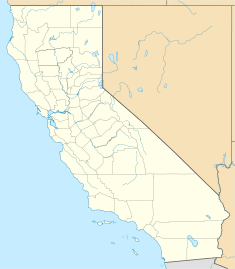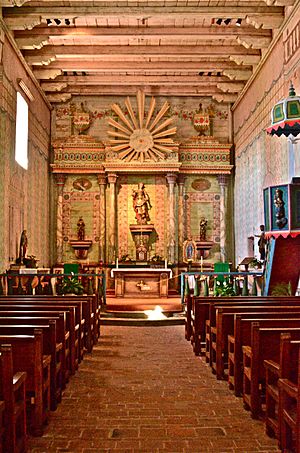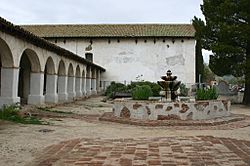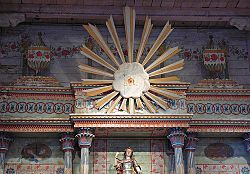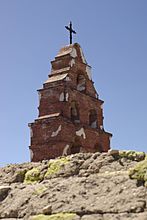Mission San Miguel Arcángel facts for kids
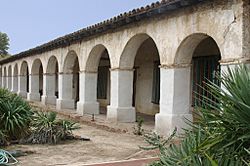
San Miguel's various-sized arches are a noted feature of this mission
|
|
| Location | 775 Mission Street San Miguel, San Luis Obispo County, California 93451 |
|---|---|
| Coordinates | 35°44′41″N 120°41′53″W / 35.74472°N 120.69806°W |
| Name as founded | La Misión del Gloriosísimo Príncipe Arcángel, Señor San Miguel |
| English translation | The Mission of the Very Glorious Archangel Prince, Sir Saint Michael |
| Patron | Saint Michael the Archangel |
| Nickname(s) | "Mission on the Highway" ... "The Unretouched Mission" |
| Founding date | July 25, 1797 |
| Founding priest(s) | Father Fermín Lasuén |
| Area | 0.4 acres (0.16 ha) |
| Built | 1821 |
| Architectural style(s) | Spanish/California Mission Style |
| Founding Order | Sixteenth |
| Military district | Third |
| Native tribe(s) Spanish name(s) |
Salinan |
| Native place name(s) | Valica |
| Baptisms | 2,471 |
| Marriages | 764 |
| Burials | 1,868 |
| Secularized | 1834 |
| Returned to the Church | 1859 |
| Governing body | Diocese of Monterey |
| Current use | Parish Church |
| Designated | July 14, 1971 |
| Reference no. | 71000191 |
| Designated | March 20, 2006 |
| Reference no. | #326 |
| Website | |
| http://www.oldmissionsanmiguel.org/ | |
Mission San Miguel Arcángel is a historic Spanish mission located in San Miguel, California. It was started on July 25, 1797, by the Franciscan order. The site was chosen because many Salinan Indians lived there. Spanish priests wanted to teach them about Christianity.
Today, the mission is still used as a church for the Diocese of Monterey. It was closed for six years after the 2003 San Simeon earthquake. The church reopened on September 29, 2009. Inside, you can see beautiful wall paintings created by Esteban Munras.
The mission is a very important historical site. It was added to the National Register of Historic Places in 1971. In 2006, it became a National Historic Landmark. Mission San Miguel Arcángel has kept more of its original buildings and layout than many other California missions. This includes parts of the village where Native Americans lived.
Contents
The Mission's Story: A Look Back in Time
Father Fermín Lasuén and Father Buenaventura Sitjar founded Mission San Miguel Arcángel. This happened on July 25, 1797. It was the sixteenth California mission to be built. Its location was perfect, as it was halfway between Mission San Luis Obispo and Mission San Antonio de Padua. This made travel much easier, cutting a two-day journey in half.
At first, a simple wooden church and living quarters were built. The mission was placed near a Salinan Indian village called Vahca. In 1798, a larger chapel replaced the small first church. Later, between 1816 and 1818, a new church was constructed. This church had a tile roof and a courtyard.
Changes Over Time: From Mission to Private Hands
After the Mexican secularization act of 1833, the mission's land was sold off. The William Reed family lived in the mission buildings for a time. Sadly, they were murdered by thieves in 1848. A group of people tracked down the killers. Two thieves died in a fight, and three others were caught and executed. After the mission was no longer run by the church, its buildings started to fall apart. Padre Abella, the last Franciscan priest there, passed away in July 1841.
Returning to the Church: A New Beginning
In 1859, the U.S. government gave the mission back to the Catholic Church. However, the buildings were in bad shape. No priests were assigned to live there. Parts of the mission were rented out to small businesses. In 1878, the Church officially reopened the mission. Reverend Philip Farrelly became its first pastor. Then, in 1928, the mission was returned to the Franciscan Padres. These were the same religious group who had founded the mission back in 1797.
What Makes Mission San Miguel Special?
- The Mission Arcade: This is a series of 12 arches that are still original. They come in different shapes and sizes, which was planned. This arcade is a famous feature of the mission.
- The Church Building: The first chapel was replaced within a year. That second chapel burned down in a fire in 1806. The church you see today was built between 1816 and 1818. It is 144 feet (44 meters) long, 27 feet (8.2 meters) wide, and 40 feet (12 meters) high.
- Historic Cemetery: Next to the church is a cemetery. It holds the remains of 2,249 Native Americans. Their burials are recorded in the mission's old records.
- Original Wall Paintings: The colorful paintings on the walls inside the church are truly special. They are the original artwork created by artist Esteban Munras and other Salinan artists in the 1820s.
The Important Role of Mission Bells
Bells were extremely important for daily life at any mission. They rang for many reasons throughout the day. Bells called people to meals and to work. They also signaled religious services. Bells were rung during births and funerals. They would even announce when a ship was arriving or a missionary was returning. New priests learned the special ways to ring the mission bells.
Nearby Historic Places
The Rios-Caledonia Adobe was built in 1835. It is just south of Mission San Miguel. This building was once a home for the person who managed the mission's lands. Today, this historic site is well-preserved. The original inn and stagecoach stop are now a museum and a small gift shop. A building added in 1930 now serves as a unique history research library. San Luis Obispo County Parks maintains the grounds. There are picnic areas and restrooms for visitors.
The Historic Rios-Caledonia Adobe is a California Historical Landmark (#936). It is also listed on the National Register of Historic Places (#71000190).
Images for kids
More to Explore
- Spanish missions in California
- List of Spanish missions in California
- USNS Mission San Miguel (AO-129) – a large ship built during World War II.
- Ygnacio Coronel (1795–1862). He was appointed to manage the mission after it was no longer run by the church in 1836.
- List of National Historic Landmarks in California
See also
 In Spanish: Misión San Miguel Arcángel para niños
In Spanish: Misión San Miguel Arcángel para niños


